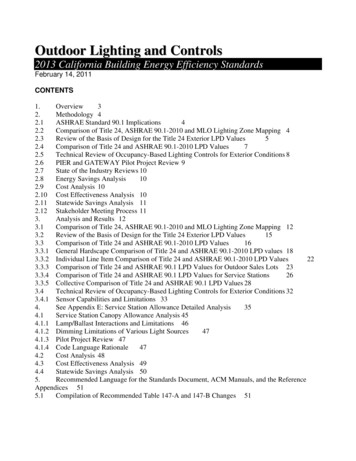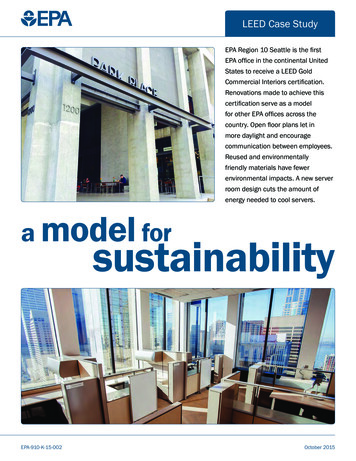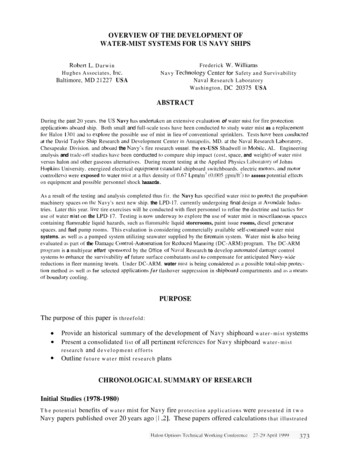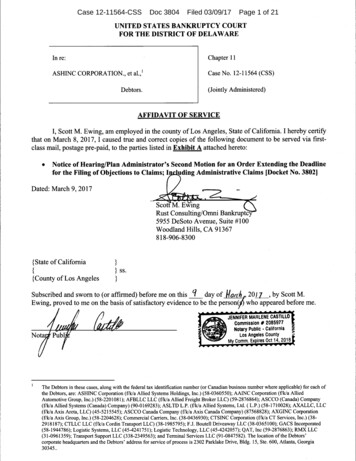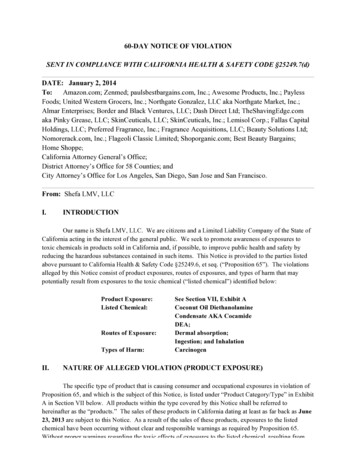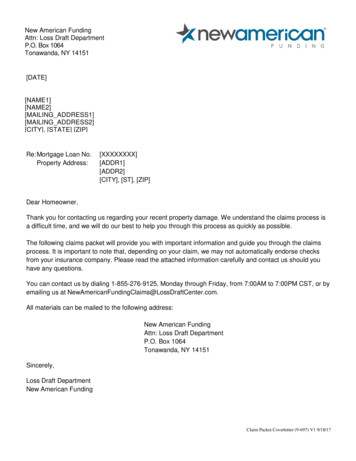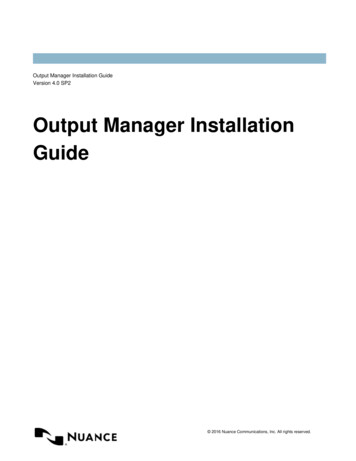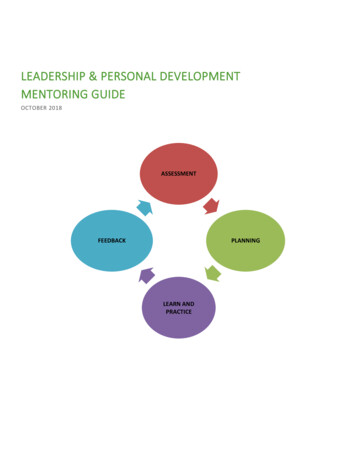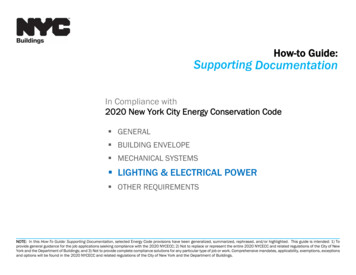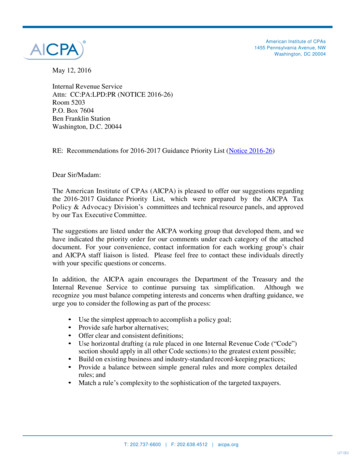
Transcription
American Institute of CPAs1455 Pennsylvania Avenue, NWWashington, DC 20004May 12, 2016Internal Revenue ServiceAttn: CC:PA:LPD:PR (NOTICE 2016-26)Room 5203P.O. Box 7604Ben Franklin StationWashington, D.C. 20044RE: Recommendations for 2016-2017 Guidance Priority List (Notice 2016-26)Dear Sir/Madam:The American Institute of CPAs (AICPA) is pleased to offer our suggestions regardingthe 2016-2017 Guidance Priority List, which were prepared by the AICPA TaxPolicy & Advocacy Division’s committees and technical resource panels, and approvedby our Tax Executive Committee.The suggestions are listed under the AICPA working group that developed them, and wehave indicated the priority order for our comments under each category of the attacheddocument. For your convenience, contact information for each working group’s chairand AICPA staff liaison is listed. Please feel free to contact these individuals directlywith your specific questions or concerns.In addition, the AICPA again encourages the Department of the Treasury and theInternal Revenue Service to continue pursuing tax simplification. Although werecognize you must balance competing interests and concerns when drafting guidance, weurge you to consider the following as part of the process: Use the simplest approach to accomplish a policy goal;Provide safe harbor alternatives;Offer clear and consistent definitions;Use horizontal drafting (a rule placed in one Internal Revenue Code (“Code”)section should apply in all other Code sections) to the greatest extent possible;Build on existing business and industry-standard record-keeping practices;Provide a balance between simple general rules and more complex detailedrules; andMatch a rule’s complexity to the sophistication of the targeted taxpayers.T: 202.737-6600 F: 202.638.4512 aicpa.org
Internal Revenue ServiceMay 12, 2016Page 2 of 2The AICPA is the world’s largest member association representing the accountingprofession, with more than 412,000 members in 144 countries, and a history of serving thepublic interest since 1887. Our members advise clients on Federal, state and internationaltax matters and prepare income and other tax returns for millions of Americans. Ourmembers provide services to individuals, not-for-profit organizations, small and mediumsized businesses, as well as America’s largest businesses.The AICPA welcomes the opportunity to discuss these comments. If you have anyquestions, please contact me at (801) 523-1051, or tlewis@sisna.com; or Melissa Labant,AICPA Director of Tax Policy & Advocacy at (202) 434-9234, or mlabant@aicpa.org.Sincerely,Troy K. Lewis, CPAChair, AICPA Tax Executive CommitteeEncl.
AICPA Tax DivisionComments on the2016 - 2017 Guidance Priority List (Notice 2016-26)May 16, 2016Corporations and Shareholders Taxation Technical Resource Panel (Kevin Kaiser,Chair, (612) 371-2467, kevin.kaiser@ey.com; or Kristin Esposito, Senior TechnicalManager – AICPA Tax Policy & Advocacy, (202) 434-9241, kesposito@aicpa.org.)NOTE: Comments are listed in priority order.Consolidated Returns1.Provide guidance regarding the treatment of intercompany transactions indetermining satisfaction of the gross receipts test for purposes of section165(g)(3)(B).12.Provide additional guidance as to the application of section 382(h)(6) inconjunction with Notice 2003-65, 2003-2 C.B. 747, within consolidation.3.Provide guidance for determining when the Continuity of Business Enterprise(COBE) requirement is satisfied following a section 382 ownership change.4.Provide additional guidance under Treas. Reg. § 1.1502-36: Provide guidance that would permit a reattribution of losses where a worthlessstock deduction is taken on subsidiary stock and the subsidiary ceases to be amember of the group but does not have a separate return year. Regarding the interaction of Treas. Reg. §§ 1.1502-11(c) and 1.1502-28 (i.e.,how does Treas. Reg. § 1.1502-36 apply in a year when there is a dispositionat a loss in the same year as a cancellation of debt event subject to Treas. Reg.§§ 1.1502-28 and 1.1502-11(c)).5.Provide guidance that would permit a worthless stock deduction with respect to aclass of subsidiary stock notwithstanding that there is a section 381 transactionwith respect to other classes of subsidiary stock.6.Provide guidance with respect to group continuation and the application of Rev.Rul. 82-152. Specifically, reevaluate the existing group continuation rules underTreas. Reg. § 1.1502-75(d) to eliminate the uncertainty that exists as a result ofthe expanded application of Rev. Rul. 82-152.All references to “section” or “§” are to the Internal Revenue Code of 1986, as amended, and allreferences to “Treas. Reg. §” and “regulations” are to U.S. Treasury regulations promulgated thereunder.1
7.Provide guidance on uncertain tax position (UTP) reporting of an acquiringcorporation on its Schedule UTP, Uncertain Tax Position Statement: Whether an acquiring corporation needs to report on its Schedule UTP, a taxposition taken on a selling consolidated group’s pre-closing consolidatedreturn for which the selling group did not record a reserve. Whether an acquiring corporation needs to report on its Schedule UTP on theacquiring consolidated group’s post-closing return, tax positions already takenon a selling consolidated group’s return (where the “only once rule” applies).8.Provide guidance that excludes the application of section 351(g) to redemptivetransactions between members of a consolidated group where a member redeemsits stock through the issuance of non-qualified preferred stock as defined undersection 351(g).9.Provide guidance concerning the application of Rev. Rul. 99-6 involvingmembers of a consolidated group.10.Finalize the regulations under section 1502.Corporations and Their Shareholders11.12.Provide guidance under section 382: Provide guidance on identifying five percent shareholders of publiccompanies. Provide guidance under sections 382 and 384, including regulations regardingbuilt-in items under section 382(h)(6).Provide guidance with respect to section 108: Provide guidance concerning how an election under section 108(i) affects thedetermination of recognized built-in gain or loss under section 382(h)(6). Provide guidance as to the application of section 108(e)(6) if the subsidiary isinsolvent before the contribution of the debt.13.Provide updated guidance regarding transactions involving receipt of no netequity value.14.Provide guidance as to what represents a “characterization” for purposes ofsection 385(c)(1) regarding a characterization of an interest as stock orindebtedness.2
15.Strongly consider releasing a list(s) of specific common organizational actionsthat require (or do not require) reporting on Form 8937, Report of OrganizationalActions Affecting Basis of Securities, to help taxpayers understand the filingrequirement, without the administrative burden and cost that a taxpayer may needto incur to verify if reporting is necessary.16.Provide guidance on the application of the solely voting stock requirement,meaningless gesture doctrine and deemed issuances under section 368(a)(1)(C) inthe event of an upstream reorganization where no actual shares are issued and thetransferee corporation has multiple voting and non-voting classes of stock.17.Provide additional guidance on the following areas: Whether a “distributing” corporation’s distribution of the stock of a“controlled” corporation meets the requirements of section 355(a)(1)(A)where, in anticipation of the distribution, the distributing corporation acquirescontrol of the controlled corporation through a recapitalization or issuance ofnew stock resulting in a “high vote/low vote” structure; Whether either section 355 or section 361 applies to a distribution of a“controlled” corporation’s stock or securities in exchange for, and inretirement of, any debt of the distributing corporation if such debt was issuedin anticipation of the distribution; and Whether a contribution of property and a distribution of property in a socalled “north-south” transaction are respected as separate transactions forfederal income tax purposes.18.Provide guidance on the scope and application of the rescission doctrine asdescribed in Rev. Rul. 80-58, 1980-1 C.B. 181.19.Provide guidance on how to determine the amount of gain or loss that isrecognized if an exchange of excess principal amount (as defined in section354(a)(2)) occurs.20.Finalize the regulations under section 597.Financial Institutions and Products21.Regulations under section 249 relating to the amount of a repurchase premiumattributable to the cost of borrowing.22.Provide guidance regarding the applicability of section 305(c).3
Employee Benefits Taxation Technical Resource Panel (Kelly Davis, Chair, (602)604-3526, Kelly.davis@claconnect.com; or Kristin Esposito, Senior Technical Manager– AICPA Tax Policy & Advocacy, (202) 434-9241, kesposito@aicpa.org.) NOTE:Comments are listed in priority order.Retirement Benefits1.Provide guidance on international tax issues relating to qualified retirement plansto aid in the administration and operational compliance with the plan terms.2.Provide model language for preapproved qualified plan documents to provide forthe deferral of compensation for unused vacation and leave time.3.Provide guidance to simplify the correction methods under the Employee PlansCompliance Resolution System (EPCRS) as they pertain to correcting actualdeferral percentage (ADP) and actual contribution percentage (ACP) testingfailures after the 12-month statutory correction period has expired.Correction methods currently available under the EPCRS as they pertain tocorrecting ADP and ACP testing failures, after the 12-month statutory correctionperiod has expired can be inordinately expensive relative to the size of the failure.Therefore, we recommend the Internal Revenue Service (IRS or “Service”) revisitthe correction methods available to provide expanded guidance that promotescompliance in a more cost effective and efficient manner.For 401(k) retirement plans, the ADP and ACP tests provide a limit on theamount of certain benefits provided under a plan to highly compensatedemployees over benefits provided to non-highly compensated employees. A planannually satisfies these nondiscrimination requirements if the plan passes theADP or ACP tests; however, if a plan fails these tests for a given plan year,corrective action must be taken within the 12-month statutory correction periodfollowing the close of the plan year in which the failure occurred. Any correctiveaction shall be made in accordance with the EPCRS. Failure to correct within thestatutory correction period will result in plan disqualification if the plan is notsubsequently corrected in accordance with EPCRS.4.Adapt EPCRS to take into account corrections of Roth employer retirement plans.5.Provide guidance to assist plan sponsors in correcting areas of noncompliancerelating to Rollovers as Business Start-ups (ROBS).Rollovers, as a business start-up, are an arrangement in which a prospectivebusiness owner uses their retirement funds to pay for their new business start-upcosts in a tax-free transaction. The prospective business owner rolls over theirexisting retirement funds to the ROBS plan, where the ROBS plan uses the4
rollover assets to purchase stock of the new business, resulting in the ROBS planowning the new business. It has been our members’ experience, that many ROBSplan sponsors are unaware that the plan is a qualified plan with its own set ofregulatory requirements. We also think that noncompliant ROBS plans are costlyto correct and can result in discrimination, prohibited transactions, plandisqualification and adverse tax consequences to the plan sponsor and planparticipants.Executive Compensation, Health Care and Other Benefits, and Employment Taxes6.Issue Consolidated Omnibus Budget Reconciliation Act (COBRA)-relatedguidance, including guidance on the applicability of section 162(l) to COBRApremiums.7.Provide guidance on the treatment of partnership employees working for a singlemember limited liability company (SMLLC) or other disregarded entity owned byan upper tier partnership (after the SMLLC employment tax reporting ruleschanged, effective in 2009). Specifically provide guidance on whether an ownerof the upper tier entity is treated as a partner or an employee if he or she providesservice to the lower tier SMLLC or other disregarded entity.8.Provide regulations to implement section 3121(z) related to foreign employers, asadded by section 302 of the Heroes Earnings Assistance and Relief Tax Act of2008.9.Finalize the regulations under 1.409A-4 related to income recognition and provideconsolidated guidance on the section 409A correction procedures.10.Finalize the regulations on cafeteria plans under section 125. Proposedregulations were published on August 6, 2007. Also, regulations are neededunder section 4980G on interaction of section 4980G and section 125 with respectto comparable employer contributions to employees’ health savings accounts.11.Issue proposed regulations under section 457(f).12.Provide guidance under the Patient Protection and Affordable Care Act (ACA)with regards to certain treaty-based nonresidents and other situations involvingdual status residents to clarify under which circumstances they are exempt fromminimum essential coverage (MEC).Under section 5000A(a), applicable individuals are required to have MEC.Section 5000A(d)(3) provides an exemption from MEC for nonresidents: “Suchterm shall not include an individual for any month if for the month the individualis not a citizen or national of the United States (U.S.) or an alien lawfully presentin the United States.”5
Furthermore, Treas. Reg. § 1.5000A-3 provides:a. Treasury Reg. § 1.5000A -3(c) (1): In general. An individual is an exemptindividual for a month that the individual is an exempt noncitizen.b. Treasury Reg. § 1.5000A -3(c) (2): Exempt noncitizens. For purposes of thissection, an individual is an exempt noncitizen for a month if the individual:(i) Is not a U.S. citizen or U.S. national for any day during the month; and(ii) Is either:a. A nonresident alien (within the meaning of section 7701(b)(1)(B))for the taxable year that includes the month; orb. An individual who is not lawfully present (within the meaning of45 CFR 155.20) on any day in the month.Clarification is needed, for example, in the determination of whether or not anindividual who met the substantial presence test based on the number of days theywere present in the U.S., and by default, would be considered a U.S. resident, butunder an income tax treaty is considered to be a nonresident, is exempt fromMEC. It is currently unclear if that individual is considered an “exemptnoncitizen” for purposes of qualifying for an exemption from MEC.Clarification of the exemption from MEC in the case of dual-status individuals isalso needed.Exempt Organizations Taxation Technical Resource Panel (Elizabeth E. Krisher,Chair, (412) 535-5503, bkrisher@md-cpas.com; or Ogochukwu Anokwute, LeadTechnical Manager – AICPA Tax Policy & Advocacy, (202) 434-9231,oanokwute@aicpa.org.) NOTE: Comments are listed in priority order.1.Request for additional guidance from the IRS on the definition of the term“acquisition indebtedness.” The current private rulings do not offer clarity on thefollowing four issues: The timing of the borrowing and the acquisition of property; The “but for” test focus on causation; Difficult factual issues raised by the “but for” test and the “reasonablyforeseeable” tests. The examples in the regulations do not provide anyguidance on how difficult factual issues should be resolved; and6
Differences in the second and third subpart of the definition.2.Provide guidance similar to the guidance set forth by the IRS in Rev. Proc. 201133. The guidance should provide that any grantor (most particularly, a privatefoundation) should be able to affirmatively rely upon the “Type” of supportingorganization that is reported by the filing supporting organization on a dulyexecuted and filed Form 990, Return of Organization Exempt From Income Tax,Schedule A, Public Charity Status and Public Support, Part I, Line 11a throughLine 11d.3.Update Rev. Proc. 89-23 to clarify guidelines for grant-making privatefoundations when making grants to public charities that would be significantenough to alter the non-private foundation status of the public charity (i.e., frompublic charity to private foundation – so called “tipping”). Clarifying guidance isneeded to:4. Address the impact of the changes to the support test as provided by section170(b)(1)(A)(vi) and Form 990, Schedule A, including the years to include inthe support test and use of books and records when completing the supporttest; Clarify that grants from a private foundation to a Type III Non-functionallyIntegrated Supporting Organization under 509(a)(3) are not consideredqualifying distributions for purposes of section 4942; and Update the language to provide that advanced rulings have expired.Provide guidance limiting the reporting on Form 990, Schedule R, RelatedOrganizations and Unrelated Partnerships, Parts III and IV of brother-sisterrelated party affiliates of central or subordinate members of a group exemptionsimilar to the exclusion from reporting of tax-exempt members of the group.For example, there may be hundreds of organizations taxable as partnerships orcorporations that are affiliated with a particular church whose exempt membersare covered by a group ruling and not reportable in Schedule R, Part II. But manyof those taxable entities may meet the technical definition of related partiesmerely because of the centralized structure at some high level in the church and assuch are currently reportable on multiple Forms 990 for the various memberscovered by the group ruling. However, there may be no board overlap orintercompany transactions with those entities beyond their direct owners and theirbrother-sister affiliates controlled by their direct owners. Provide guidancelimiting the reporting to only those related parties directly controlled by the filingorganization or with whom the filing organization has engaged in transactionsexceeding a fixed dollar amount.7
5.Provide guidance, similar to Notice 2007-45, to expand on information regardingpublic inspection of Forms 990. The IRS released guidance on the publicinspection of Form 990-T, Exempt Organization Business Income Tax Return.This guidance explains that section 501(c)(3) organizations that filed Form 990-Tafter August 17, 2006 are subject to the same public inspection and disclosurerequirements that apply to Forms 990 and 990-PF, Return of Private Foundation.The notice further clarifies that a section 501(c)(3) organization that is notrequired to publicly disclose its Form 990 must still publicly disclose its Form990-T. This guidance regarding public disclosure is needed for all other Forms990.6.Provide additional guidance that allows organizations that have exempt statusrevoked for failure to make required annual filings for three years under section6033(j) the option to request prospective reinstatement and simultaneously, butseparately, request retroactive reinstatement to be determined at a later date. Thisrecommendation allows an organization that qualifies to resume operations andsolicit the contributions it needs to survive as an organization. It also allows theIRS additional time to properly consider whether reasonable cause exists for theretroactive reinstatement.7.Provide guidance regarding the new excise taxes on donor advised funds and fundmanagement under section 4966 as added by section 1231 of the PensionProtection Act of 2006 (PPA).8.Update Rev. Proc. 75-50, which speaks to the publication of a school’s raciallynondiscriminatory policy. This language has not been updated since itspublication and Form 990, Schedule E, Schools, relies upon it. The revenueprocedure generally requires publication of the policy in a newspaper. Thelanguage needs to be revised and updated to reflect the role of the internet and thecurrent communication mediums of schools today.9.Affirm that the conclusion and analysis set forth in General Counsel Memoranda(G.C.M.) 39813 represents the current IRS position with respect to the taxtreatment of public charities whose exemptions have been retroactively revoked.If such is not the case, provide guidance as to the current position of the IRS.Pursuant to the PPA, most tax-exempt organizations were required to file anannual information return (Form 990 or 990-EZ, Short Form Return ofOrganization Exempt from Income Tax) or a notice (Form 990-N, e-Postcard)with the IRS. In addition, the law automatically revokes the tax-exempt status ofany organization that does not file required returns or notices for threeconsecutive years. Although guidance has been issued with respect toreinstatement and retroactive reinstatement, no guidance has been provided withrespect to the tax treatment of such retroactively revoked public charities.8
10.Issue a revenue procedure allowing all members under a group ruling (includingthe central organization and the subordinate organizations) to file a singleconsolidated return rather than the current process which requires a separatereturn for the central organizations and a consolidated return for all consentingsubordinates. The American Institute of CPA’s (AICPA) strongly believes asingle consolidated return more accurately reflects the operations of the group.11.Clarify who constitutes a “patient” for purposes of the definition of “patient care.”For example, would the following services be considered “patient care”(especially when the individual receiving the services is not an inpatient of ahospital at the time the services are rendered): services provided via atelemedicine network or reading of images, laboratory services and pathologyservices where the technician or physician interpreting the tests does not actuallysee or “touch” the patient. Such guidance under section 501(r) would reduceuncertainty and support the move toward accountable care organization (ACO)and cost effective health care methods. In addition, absent guidance, costlyinformation technology changes are being made by hospitals which will likelyhave to be made again when guidance is finally issued.Individual and Self-Employed Tax Technical Resource Panel (Ken Rubin, Chair,(314) 290-3417, ken.rubin@rubinbrown.com; or Amy Wang, Senior Technical Manager– AICPA Tax Policy & Advocacy, (202) 434-9264, awang@aicpa.org) NOTE:Comments are listed in priority order.1.Provide guidance regarding issues of basis reporting on Form 1099-B, Proceedsfrom Broker and Barter Exchange Transactions. Since basis reporting on Form1099-B began with 2011 tax returns, various issues have arose that warrantguidance. We encourage the IRS to request comments from the public to uncoveradditional issues to ensure that extended guidance addresses all issues. Examplesof issues with the basis reporting include the following: How do taxpayers and practitioners properly report the sale of a publiclytraded partnership? Broker-reported basis is not reflective of any return ofcapital or other changes to taxpayer’s original basis. In addition, for royaltytrusts, a broker has no information on what amount of depletion has beendeducted by the taxpayer. Gain or loss must be split between capital andordinary gains or losses. How do taxpayers and practitioners properly report corrections to amountsindicated as “wash sale loss disallowed” where the broker used aninappropriate method of calculating figures reported to the IRS and taxpayer? How should taxpayers and practitioners respond to matching notices when thecorrect basis, gross proceeds, gain/loss, holding period and tax have been9
reported by the taxpayer on the return but either the wrong box was checked(A or B) on Form 8949, Sales or Other Dispositions of Capital Assets, or theimproper adjustment code was entered on Form 8949 by the taxpayer? 2.How should taxpayers and practitioners report 1099-B sales where the brokerreported holding period is incorrect?Guidance is needed with respect to when a real estate leasing arrangement rises tothe level of a trade or business requiring Form 1099-MISC reporting by the lessor. Public Law (P.L.) 111-240 (9/27/10), the Small Business Lending Fund Act of2010, modified section 6041 to add subsection (h) requiring certain landlordsto file Form 1099-MISC, Miscellaneous Income, for payments made forservices in excess of 600. The legislative history provided: “Under theprovision, recipients of rental income from real estate generally are subject tothe same information reporting requirements as taxpayers engaged in a tradeor business. In particular, rental income recipients making payments of 600or more to a service provider (such as a plumber, painter, or accountant) in thecourse of earning rental income are required to provide an information return(typically Form 1099-MISC) to the IRS and to the service provider.” Thisnew provision was effective starting after 2010. P.L. 112-9 (4/14/11), the Comprehensive 1099 Taxpayer Protection andRepayment of Exchange Subsidy Overpayments Act of 2011, repealed section6041(h) retroactive to January 1, 2011. Thus, the 1099 reporting obligationfor landlords never went into effect. Despite repeal of section 6041(h), since 2011 the Form 1040, U.S. IndividualIncome Tax Return, Schedule E, Supplemental Income and Loss, and theinstructions have included the following two questions (A and B):These questions contradict the legislative history of P.L. 111-240 (above) andrepeal of section 6041(h). With these questions added to Schedule E rather thanSchedule C, Profit or Loss from Business, they imply that it may require landlordswho are not in a trade or business to file Form 1099-MISC. The questions raiseissues as to the distinction between a real estate rental that qualifies as a trade orbusiness for section 6041 purposes and one that does not.10
In addition, the form instructions were also revised. Under the instructions forSchedule E, line A, the following language now appears (bold type added):TIP: Generally, you must file Form 1099-MISC if you paid at least 600 in rents, services, prizes, medical and healthcare payments, and otherincome payments. The Guide to Information Returns in the 2015 GeneralInstructions for Certain Information Returns has more information,including the due dates for the various information returns.However, under “General Instructions,” the following language still appears (boldtype added):“Information returns. You may have to file information returns forwages paid to employees, certain payments of fees and other nonemployeecompensation, interest, rents, royalties, real estate transactions, annuities,and pensions. You generally use Form 1099-MISC to report rents andpayments of fees and other nonemployee compensation. For details, seeline A, later, and the 2015 General Instructions for Certain InformationReturns.”The phrasing of “you may” that appears in the General Instructions has been usedin the instructions for Schedule E for many years, and we believe is accurate. Thenew phrasing “generally, you must” used in the line A TIP is simply misleading.Clarification is needed under section 6041 as to when an owner of rental realestate is required to file Form 1099-MISC. Also, given the use of the term tradeor business and special rules for rental real estate included under section 1402(self-employment tax), section 469 (passive activity loss limitation) and section1411 (special tax on net investment income), further guidance should explain howall of these rules apply to owners of rental real estate. In addition, individualsshould receive relief if they are rental real estate owners who are required to fileForm 1099-C, Cancellation of Debt, but failed to file for 2012, 2013 or 2014 dueto the confusion in the law and instructions for Schedule E and Form 1099-MISC.3.Update and finalize the longstanding temporary regulations under section 163(h)(Treas. Reg. § 1.163-9T and 1.163-10T) to provide greater clarity and certainty totaxpayers and practitioners.The Tax Reform Act of 1986 made changes to section 163 regarding personal andhome mortgage interest. Further changes were made to the home mortgageinterest rules by the Revenue Act of 1987. Temporary regulations were issued onthese provisions soon after the legislative changes. Several of the regulationswere issued prior to the effective date of the change made to section 7805 by theTechnical and Miscellaneous Revenue Act of 1988 providing that temporaryregulations expire within three years of issuance (effective for regulations issued11
after November 20, 1988). Thus, temporary regulations issued after enactment ofthe Tax Reform Act of 1986 and before November 21, 1988, which have not beenfinalized, remain in their temporary form.In addition, not all of the regulations are complete or current, such as Treas. Reg.§ 1.163-10T on home mortgage interest. Among unsettled issues are thefollowing:4. Section 163(h)(4)(A) does not provide certainty on how to define a qualifiedresidence or a second residence in the context of divorce. Must the taxpayer have responsibility for the mortgage and own theunderlying property before the interest is deductible? (Or, may the taxpayersatisfy only one of these two requirements?) For example, a husband maytransfer ownership of the residence to the wife, but remain responsible for themortgage. Is the interest deductible? What is the proper method to determine deductible qualified residence interestwhen there are multiple debts that exceed the debt limit? While ChiefCounsel Advice (CCA) 201201017 and IRS Publication 936 provideinformation on this question, official guidance is needed, such as inregulations.Update and finalize the longstanding tempor
relating to Rollovers as Business Start-ups (ROBS). Rollovers, as a business start-up, are an arrangement in which a prospective business owner uses their retirement funds to pay for their new business start-up costs in a tax-free transaction. The prospective business owner rolls over their
